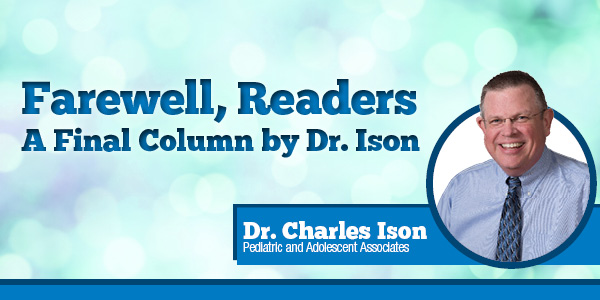Dr. Ison Reflects on 22 Years of Writing About Pediatric Issues
By Charles G. Ison, M.D.
Congratulations to Lexington Family on being 22 years old! I have been a columnist for this magazine since it came into being. They inherited me from Lexington Kids magazine, one of the two publications that merged to form this one that you are currently reading.
My columns have dealt with a large variety of pediatric issues over the years. I have revisited some topics that were important for newer parents to read or that became important as older parents’ children moved into new developmental stages.
Pediatrics itself has changed in the past 22 years. Sometimes I have had to change what information goes into newer columns on perennial issues.
One of the biggest challenges facing pediatrics is that the U.S. birth rate has dropped significantly since 1997. The rate then was 14.2 births per 1,000 population. As of 2018 (the last full year as of this writing), the U.S. birth rate was at a record low of 11.6 births per 1,000 population.
Fewer kids being born does not bode well for the need for pediatricians.
At the same time, the teen birth rate has gone down significantly. In 1997, there were 52.3 births per 1,000 females 15-19 years old. In 2018, the rate had plunged to 17 births per 1,000 females 15-19 years old. The abortion rate for females 15-19 years of age is also much lower than it was in 1997.
Although not all teen pregnancies are unplanned, many are. Waiting on having babies until a woman is in her 20s can lead to better outcomes overall for her baby and herself.
Women overall are waiting until they are older to start having children. The late 20s is now the most popular time for women to have their first child. First-time fathers’ average age is now 30, which is also older than it used to be.
The rise of the Internet has allowed parents – and some kids – to look up information about pediatric issues themselves. Pediatricians are now competing with a plethora of informational sites. Some of these are good sources and some are completely bogus.
Smart phones can allow parents to look up information in real time as I talk to them. They can also text other caregivers to ask questions about children I am seeing. This is often very helpful.
On the other hand, very young children to teenagers will be mesmerized looking at their little screens as I talk to their parents (or to them).
Along with the rise of the Internet and coinciding with a debunked and retracted journal article by a now-unlicensed British physician that was published in 1998, the anti-vaxxer movement took life and took off.
Moving from one disproven conspiracy theory about the supposed danger of vaccines to another as each is disproved, this bizarre alliance has made practicing pediatrics much more difficult over the past 22 years.
Previously, vaccines were assumed, and rightly so, to have some risk of side effects but to be important for the health of children and the community at large.
Now significant numbers of parents, especially in some areas, want to delay vaccines, decrease how many are given, or not give their children any at all.
Thanks to these anti-vaxxers, measles, a disease that can kill children, has gone from being eliminated in the U.S. in 2000 to multiple outbreaks this year. It is on the verge of becoming a perennial problem here once again.
In the past 22 years, new vaccines have been developed and have come into widespread use in the U.S. These include immunizations against rotavirus, hepatitis A, pneumococcal meningitis and human papillomavirus.
Children do get a lot more immunizations now than they did in 1997, and I have much longer discussions with parents (and often their kids) about vaccines in general. The irony is that despite more being given, immunizations are a lot safer in general than they were 22 years ago.
I do not miss seeing a lot of the diseases they prevent, either.
I have had a good run writing these columns for Lexington Family Magazine. Times change, though, and formats change. As Lexington Family Magazine moves out of print and into a totally online existence, I am taking this opportunity to gracefully bow out.
This is my last column for this great and important publication. I appreciate the opportunity that it has given me and how it has improved my writing over the years. That is mostly due to editor John Lynch’s very patient work with me.
I have learned a lot doing these columns. I hope you all have learned a little something, as well.

